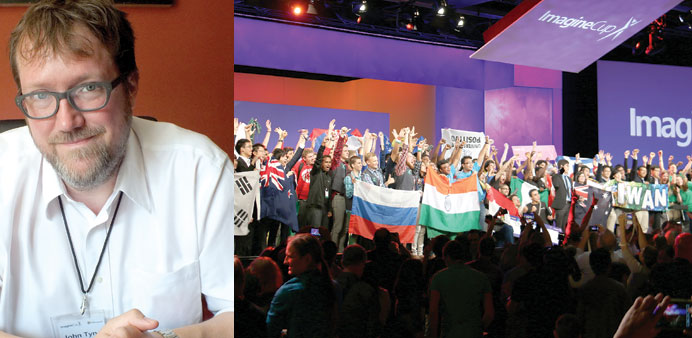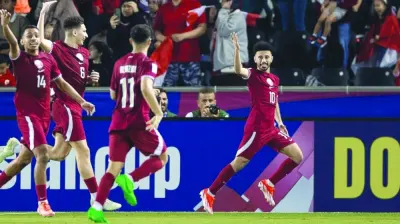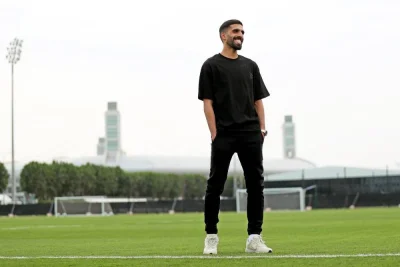WORLD STAGE: Students, who competed for the Imagine Cup World Championships 2014, pose before the cameras at the Washington State Convention Center.
INSET: SATISFIED: “I’m really happy to see the quality bar going up this year,” says Tynes. Photos by the author
By Kamran Rehmat
SEATTLE — I saw the towering six foot plus figure become one of the boys, hip hopping to the beat of peppy music on stage — like most students who let their hair down — at a post-event party at the EMP Museum in Seattle. It was the night on first August that followed awards at the Microsoft-sponsored Imagine Cup World Championships earlier in the day at the Washington State Convention Center.
John Scott Tynes was in his elements as he usually is when at work, too. Being In Charge of Imagine Cup — the premier global student technology competition — worldwide is, in his words, an amazing job. He is otherwise a prolific writer, game designer and even film critic rolled into one.
Settled in Seattle, Tynes founded Pagan Publishing at 19, and later Armitage House. He has worked or written for Bungie, Acclaim, Wizards of the Coast, Atlas Games, Steve Jackson Games, Daedalus Games, Chaosium, Salon, McSweeney’s Online, The Stranger, The Escapist, Tablet, and many other companies and publications.
In an exclusive interview with Gulf Times, he spoke at length about what drives him, the talent windfall at the Imagine Cup and what it means to work for Microsoft.
Why has it taken so long for Microsoft to reach home in terms of hosting the Imagine Cup? What makes this 12th edition any different from all the others apart from this trivia?
That’s a great question. You know historically, we’ve been all over the world. In the last couple of years, we’ve had some opportunities to bring teams of Imagine Cup students to Seattle to visit Microsoft for some special events and when we saw how excited the students were to visit Microsoft headquarters, we began to realise we hadn’t thought about it (hosting the Cup).
Their enthusiasm and excitement was really moving to us and so we decided to go ahead and share the excitement with as many students as we can. So we’re really happy to have them here and it has turned out to be terrific. So many Microsoft employees have got a chance to meet them and see their projects and share their opinions at the Museum of History and Industry in Seattle, for instance.
(In terms of how this edition is different from the rest), there’s a couple of things that come to mind; one, having the Cup in Seattle means there are more opportunities for students to interact with Microsoft staff and to make new friends here and get advice from people who work in the Microsoft directly. That access is terrific.
The other thing is that this year for the first time we have run a series of contests in the first part of the season beginning in September last year that were designed to get the students thinking about their projects earlier, forming teams sooner and diving deeper into planning and thinking about their work — the challenge for students to really learn about doing competitive analyses, about user personas and who their audience really is; what the key features of their projects are; get them thinking in the way a professional development team would think — but doing so long time before we get to the finals. We wanted to see stronger teams and better projects coming out in the process. And we did. Our World Semifinals round had 171 teams competing online and half of those teams came out of that process. They made great projects and we had some of those teams who won those contests here to compete for the World Finals. I’m really happy to see the quality bar going up this year.
What is the most exciting/interesting project you’ve ever seen or one that has been the closest to your heart in all these years?
Last year, we had a project that won the World Citizenship category by a young woman from Portugal who was a one-person team — it was just her — she made a project that did blood typing in the field really easily and quickly (the project was extremely useful for emergency situations, determining blood types in about 5 minutes).
Since then we’ve brought her to the Tech Museum in San Diego to introduce her to the people in Silicon Valley and she’s been able to make contacts and do more work on her project and to see that come a long way has been really exciting.
How many of the projects you’ve seen in the World Citizenship category go on to achieve their potential, especially in terms of business?
It is a tough space because the technology for good is not an area where lots of investors are clamouring to find the next space book or something. We had a team from Brazil (Liaison Team) this year; they have been working a couple of years with doctors and patients in their area to continue to develop their product and that’s the kind of strategic thinking that the teams need to have because it’s not just about having and throwing an offer out there.
This year the winner of our World Citizenship contest is not only going to win the $50,000 cash prize but we’re also going to bring them back to Microsoft to spend a week on our campus working with people on our citizenship teams, with engineers, development people, and help them make connections with the kind of people and partners they are going to need to make their projects successful.
In demographic terms, can you put a finger on where do most winners in the competition come from?
A very large number of our students across the entire Imagine Cup season come from China and India. Those two countries are where the Imagine Cup gets the biggest number of student signees from. By the time we get to the finals, we see a much more diverse group, but I’d say certainly that part of the world is doing great work with technology and remains very excited about the Imagine Cup.
Is language a barrier for students coming from some of the less developed countries?
Unfortunately, yes. Fundamentally, we operate the Imagine Cup in English in terms of language. We can’t provide translators for every competing country. Having said that, I can tell you teams for the Imagine Cup have had no problems competing — and even winning the Cup — regardless of any language impediments or their background thanks to their skill set. I think their enthusiasm and passion really help to overcome those barriers.
You’re a game designer yourself. What do you find more interesting amongst the three categories — Games, Innovation or World Citizenship?
My background is in Games, but the reality is I’m surprised by everything I see at the Imagine Cup; I see some great projects coming across the board in all categories. Even before when I was making games, I was into programming — making other softwares as well. So my interests are pretty broad and I get excited by anyone who is passionate about making projects and these students (at Imagine Cup) have that in spates.
How do you find the time to do all of these things?
(Laughs) I have a six-year-old daughter and so my family comes for me first. But I have a very strong team at Microsoft and the best thing about them is that the people here are very collaborative and when it comes to Imagine Cup, they really want to help. At this edition of the Imagine Cup, we have had so many Microsoft staff who have stepped up to help out, to give talks to students, to get involved, to volunteer. It’s a corporation where people really like to work together.
You’re a film critic, too. What genres interest you more?
I watch all kinds of movies, don’t really have a specific favourite. I’ve also reviewed Seattle Film Festival a few times.
What’s your average day like?
Lots of emails (repeats). We work very closely with our subsidiaries around the world, what with the Imagine Cup nationals and the semifinals all year long and so I have relationships with dozens of Microsoft people all over the planet who I stay in touch with. We work together all year through to make this happen. I also get to talk to the students and stay involved with them. Then there’s the website I write for.
A very large number of our students across the entire Imagine Cup season come from China and India. Those two countries are where the Imagine Cup gets the biggest number of student signees from. By the time we get to the finals, we see a much more diverse group but that part of the world is doing great work with technology



